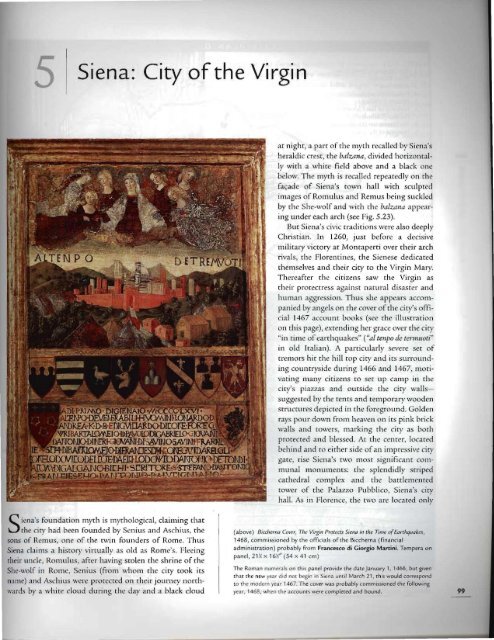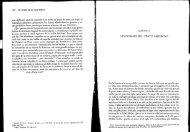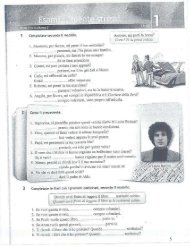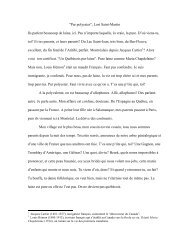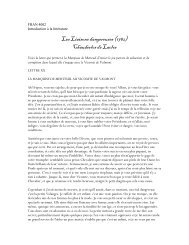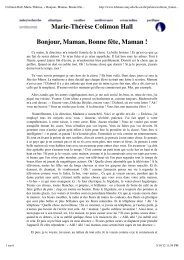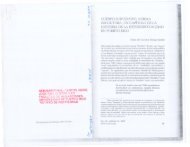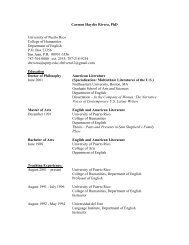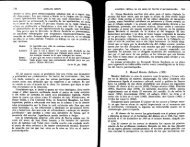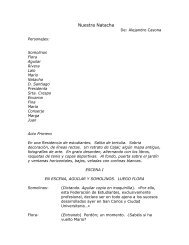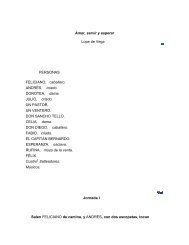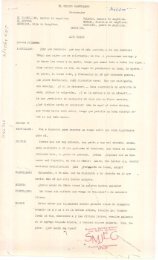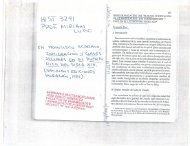Siena: City ofthe Virgin - Facultad De Humanidades
Siena: City ofthe Virgin - Facultad De Humanidades
Siena: City ofthe Virgin - Facultad De Humanidades
Create successful ePaper yourself
Turn your PDF publications into a flip-book with our unique Google optimized e-Paper software.
116<br />
Z<br />
o<br />
cr:<br />
;;<br />
u.J<br />
t<br />
L:a>t-<br />
V<br />
«<br />
z<br />
w<br />
Vl<br />
5.26 M'1e5Ici, 1317-18, co m m issio ned by Nella di Millo Tolornci from Lippa Memmi for th e Pal.1/..l0 Pubh lico, S,lI' Girnignano . Fresco<br />
The pa ired figu re, (0 th e left and the right were ad d ed by B", w lo d i Fred, when t he fresco wa s enlarged on 1367. The fresco was repai red alon g t he lower edge in the<br />
1460, by Beno zzo Gozzoli, who ma;, have rcparnted the head , of rh e two figure' ro ehe far nghT.<br />
of the Tolomei fam ily appears in the baldaccbino above . If<br />
nothing else this rather pedestrian painting indicates how<br />
powerful the language of civic imagery was. By placing the<br />
copy of Simone's Maes:« in the town hall ofSan Gimignano,<br />
Nelle made very clea r <strong>Siena</strong>'s political control over the small<br />
town and his power as legate in enforcing that control.<br />
Secular Imagery in the Sala del Consiglio<br />
Accompanying Simone's Maest« in the Sala del Consiglio<br />
in the Palazzo Pubblico were a number o f secular images.<br />
Frescoes commemorated barrles and imporranr mil itary<br />
captains, and a huge rotating map by Ambrogio Loren zetti<br />
(now destroyed) set Sienese events in a world context. One<br />
of the best surviving examples of th is reportorial art was<br />
commissioned from the painter and miniaturist Lippa<br />
Vanni (active 1341 - 75 <strong>Siena</strong>) to record th e Sienesc victory<br />
in the Val di Chiana over English mercenaries in 1363<br />
(Fig. 5.27 and see Fig. 5.25). His monochromatic fresco, like<br />
man y such civic images painted exclusively ill central Italian<br />
town halls, records the progress of the battle and the disposition<br />
of the troops episodically across the wall; it is a<br />
graphic chronicle of the event rather than a naturalistic<br />
reconstruction, wit h cities carefully labeled and the armies<br />
identified by the he rald ic flags of their leaders. Here again,<br />
function derermined style.<br />
The Sala della Pace: "Good Government"<br />
On e of the most elaborate decorative programs for the<br />
Palazzo Pubblico of <strong>Siena</strong> was commissioned from<br />
Ambrogio Lorenzetti for the room adjacent to the Sala del<br />
Consiglio in 1338. This was the meeting room of the Nine:<br />
the Sala dei Nove or the Sala della Pace (Room ofPeace). The<br />
membership of rill' Nine, who led th e Sicn ese government<br />
from 1287 to 1355 , changed every two mont hs, always<br />
drawn from th e Sienese ar istocracy, despite rep eat ed<br />
attempts to widen the sources ofrepresentation . Legislation<br />
of 1318 made rhein responsible for "the ordering and<br />
reformation of rhe whole city and contado ('countryside')<br />
of Sien a." For the Sala della Pace Loren zetti designed an<br />
allegori cal fresco cycle underscoring the benefits of good<br />
go vern m ent an d the dangers of bad gov ernment.<br />
T he cycle consists of three frescoes: the Allegory ofGood<br />
Government, the E.fJeet> ofGood Government in the <strong>City</strong> and in the<br />
COlm tIY , and Bad GO{.'('l7lmellt and the Effiet,ofn'ld G(wcmment<br />
in the Cit». The AllegolJ ofGood Government (Fig. 5.28) occupies<br />
one shorr wall of the room and is the central image in<br />
it. A complicated and fragmented work, it lack s a single<br />
compositional focus and thus must be read episodically.<br />
The largest image on the wall , and therefore, according to<br />
the hi erarchies of the period. the most important, is the<br />
seated male flgun: on the right. who is clothed in the
5.27 V,rtory o( lhe Sienesc Troop, at the Val di C/';,I(W If' 13 63 . c. 13 64 (?). Lippa Vanni, Sala d el Co nsiglio ( Room o ft he Co u nc il). Pala zzo I'ubblico. Sie na .<br />
Fresco<br />
5.28 Allegory of Good Covem ment , 13 38 -·10 . co m m issio ned by the go vern in g bo dy of I he Nine from Ambrogio Lorenzetti for til l' S,,1a della Pace (a lso known<br />
,j , the Ro o m o f t he Nin e), Pa lazzo Pu b blico, <strong>Siena</strong> . Fresco . lengt h c. 25 ' 3" (7 .7 on)<br />
The te xt in the lower ba rd." of the fresco read s: "Th is holy Virtu" [o f'j usucc ] where she rules. ind uces to unity , h,' Ill;lny ,0,,1, I" f the cirizcns ]. and the y, ga thered<br />
togelher fo r suc h a purpose, ma ke the Com mon Go od their Lord ; an d he, in ord er to govern his sta te, chooses never 10 turn Ills "yes fr'OIl1 the r",pleod erll faces <strong>ofthe</strong><br />
Virtues who , it ar o und him, Th erefo re to him in tr ium ph arc offered taxe s, trib utes an d lordship of tow ns: th" 'd",,,, without war , every Civic res ult duly folloW!>useful.<br />
necessa ry, and pleasurabl e," (Tra ns. Diana Norman)<br />
117<br />
..,<br />
I<br />
rn<br />
"'0<br />
:t><br />
r<br />
:t><br />
N<br />
N<br />
o<br />
"'0<br />
C<br />
OJ<br />
OJ<br />
r<br />
r.<br />
o
5.31 The Funeralo(the <strong>Virgin</strong>. 1406-7 , com mission ed by the<br />
Priors from Taddeo di Bartolo for th eir chapel. Palazzo<br />
Pubblico, <strong>Siena</strong>. Fresco, ' 0' 6" x t t' 4 " (3.2 X 3.45 m)<br />
employs earlier convention s of spatial organization<br />
and fig ural composition. The way Taddeo<br />
truncates th e faces <strong>ofthe</strong> a pos tles behind rile bier<br />
indicates rhar he is so metimes interested in naruralisric<br />
observation. Yet non e of rhe apostles<br />
seems to be actually bea ring the weigh t of the<br />
bier. their wiry outline an d sharp, angu lar pos es<br />
arc stoc k featu res in Taddeo's work. Along with<br />
the stylized or blank backgrou nds in the frescoes<br />
these featu res would have given the decorative<br />
program of the city hall a stylistic consist ency<br />
spannmg over a cen tury.<br />
In 1407 the Priors commissioned Spinello<br />
Aretina (Sp inello di Luca Spinelli ; 1350/ 52<br />
Arczzo - J-t lO Florence), assisted perhaps by his<br />
son, Parri Sp inelli (I3H7 Arena- 1453 Arezzo)<br />
to paint the walls of th eir meeting ro om ,<br />
the Sala dei Priori (Fig. 5.32 ). The subject matter<br />
of th e two-ti ered frescoes , wh ich cove l" all fou r<br />
walls of the room. co ncer ns the Sicnesc pope<br />
Alexander 1lI Bandinelli (r. I 159-81 ). Supposedly<br />
this subj ect was chosen as the result of a visit of<br />
Pope Gregory XII to Sien a, the frescoes being<br />
5.3 2 Scenes (rom the LiteQrAlexander III, 14 0 7, co mmission ed<br />
by the Priors from Spinello Aretino for th e Sala d e; Priori,<br />
Palazzo Pubblico , <strong>Siena</strong>. Fresco<br />
intended to remind the current incumbent<br />
of a Sicncse citizen who had been<br />
pope and who had even brought the<br />
fl'arsome lsarbarossa to his knees. They fit<br />
(he need s ofa civic site by honoring one of<br />
its fam ou s citizcns, and th ey mav also<br />
serve cont,'mporary history by suggesting<br />
a compari son between Alexander's alliance<br />
with the Lomb ards and the Priors'<br />
Milan ese alliance with the Visconti, The<br />
frescoes' Florentine sense of spaciousness,<br />
th eir massive, solid figures, and naturalis 121<br />
tic deta ils indicate th at historical narrative 00<br />
de ma nded a dramatic and naturalistic<br />
style.<br />
m<br />
Z<br />
:::<br />
In 1413- I-'I th e Priors :tgain turned to -0<br />
Taddeo di Bart olo to paint a cycle of paintorings<br />
for the anrcchapel of the Palazzo<br />
Pubblico, a space that functioned as an<br />
-i<br />
n<br />
><br />
r<br />
important passage between other room s<br />
of the palace . The Prio rs thought this<br />
space imporranr enough ro ass ign Pietro<br />
oo<br />
-c<br />
00<br />
-i<br />
m<br />
s:<br />
de ' Pecci, a lawyer and teacher in <strong>Siena</strong>,<br />
and Cr isroforo di Andrea, the city's<br />
><br />
z<br />
o<br />
n<br />
<<br />
n<br />
III<br />
><br />
;;0<br />
...,


